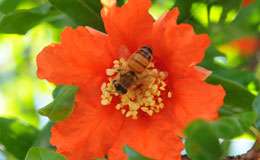Give thanks to the bee

(PhysOrg.com) -- When we sit down to give thanks at the traditional Thanksgiving dinner, we should also be thanking the honey bee.
"A substantial portion of the meal is pollinated by the honey bee," said Extension Apiculturist Eric Mussen, a member of the UC Davis Department of Entomology faculty and a noted authority on honey bees.
If your meal includes cranberries, squash, pumpkins, carrots, cucumbers (and pickles) onions, grapefruit, oranges, apples, pears, cherries, blueberries, sunflowers and almonds, thank the honey bee, said Mussen and bee breeder-geneticist Susan Cobey, manager of the Harry H. Laidlaw Jr. Honey Bee Research Facility at UC Davis.
Cobey said almonds often garnish parts of the meal, such as slivered almonds on a green bean casserole or toasted almonds on a salad or dessert.
Almonds and macadamia nuts are the key nuts pollinated by bees.
Cole crops, such as cabbage, Brussel sprouts, collards, kale, kohlrabi, spinach, chard and broccoli are also pollinated by bees.
And the turkey? No, unless the turkey dined solely on sunflower seeds. Turkeys are usually fed a variety of grains. Bees do, however, visit the plants that eventually comprise our spices, such as sage, basil and oregano.
Even milk and ice cream are linked closely to the honey bee. Cows feed on alfalfa, which is pollinated by honey bees (along with other bees). Ice cream ingredients usually include fruits and nuts, other bee favorites.
Vegetarians can also be thankful. Bees visit soybeans (made into tofu for tofu turkey and other meatless dishes). "And bees can make a honey crop foraging on lima beans," Mussen said.
The ever-popular fruit salad includes such bee favorites as blueberries, apples, oranges and pomegranates.
And don't forget the honey: honey-glazed carrots, honey rolls and honey-baked ham.
Soon to be favorites of honey bees and visitors alike are the newly planted half-acre Häagen-Dazs Honey Bee Haven and the quarter-acre Campus Buzzway, filled with wildflowers. Both will be year-around food sources for honey bees and educational experiences for visitors. The gardens are located on Bee Biology Road, next to the Laidlaw facility, on the western edge of the UC Davis campus.
Provided by UC Davis (news : web)

















